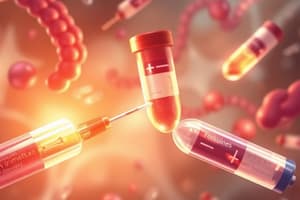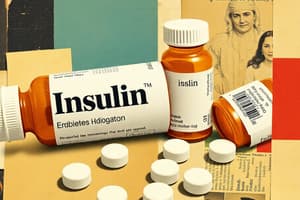Podcast
Questions and Answers
A patient with type 1 diabetes is prescribed insulin. Which type of insulin would mimic the normal endogenous insulin release in response to a meal?
A patient with type 1 diabetes is prescribed insulin. Which type of insulin would mimic the normal endogenous insulin release in response to a meal?
- Insulin lispro (correct)
- NPH insulin
- Regular insulin
- Insulin glargine
A patient is prescribed NPH insulin at 7:00 AM. The nurse anticipates the highest risk of hypoglycemia for this patient will occur during what time frame?
A patient is prescribed NPH insulin at 7:00 AM. The nurse anticipates the highest risk of hypoglycemia for this patient will occur during what time frame?
- 11:00 AM - 3:00 PM (correct)
- 4:00 PM - 10:00 PM
- 8:00 AM - 10:00 AM
- 2:00 AM - 6:00 AM
A patient with type 2 diabetes is prescribed insulin detemir. What is the primary characteristic of this insulin that the nurse should emphasize in patient education?
A patient with type 2 diabetes is prescribed insulin detemir. What is the primary characteristic of this insulin that the nurse should emphasize in patient education?
- It provides a long-lasting background level of insulin and should be taken at the same time each day. (correct)
- It has a rapid onset, so administer it 15 minutes before meals.
- It should be administered intravenously only in emergency situations.
- It can be mixed with short-acting insulin in the same syringe.
A patient newly diagnosed with type 1 diabetes asks why they need insulin injections instead of oral medication. What is the most accurate explanation?
A patient newly diagnosed with type 1 diabetes asks why they need insulin injections instead of oral medication. What is the most accurate explanation?
A pregnant patient is diagnosed with gestational diabetes. What is the physiological basis for this condition?
A pregnant patient is diagnosed with gestational diabetes. What is the physiological basis for this condition?
A patient with diabetes is admitted to the hospital with hyperglycemia. The provider orders IV insulin. Which type of insulin is appropriate to administer intravenously?
A patient with diabetes is admitted to the hospital with hyperglycemia. The provider orders IV insulin. Which type of insulin is appropriate to administer intravenously?
A nurse is teaching a patient about recognizing hypoglycemia. Which of the following instructions is most important for the nurse to include?
A nurse is teaching a patient about recognizing hypoglycemia. Which of the following instructions is most important for the nurse to include?
A patient taking insulin reports consistently high blood glucose levels in the morning, despite increasing the evening dose of long-acting insulin. What phenomenon should the nurse suspect?
A patient taking insulin reports consistently high blood glucose levels in the morning, despite increasing the evening dose of long-acting insulin. What phenomenon should the nurse suspect?
A patient is prescribed both regular insulin and NPH insulin to manage type 2 diabetes. What instructions should the nurse provide regarding the mixing of these insulins?
A patient is prescribed both regular insulin and NPH insulin to manage type 2 diabetes. What instructions should the nurse provide regarding the mixing of these insulins?
A patient with diabetes develops a foot ulcer. What is the most important aspect of patient education regarding foot care?
A patient with diabetes develops a foot ulcer. What is the most important aspect of patient education regarding foot care?
What is the treatment for a patient experiencing hypoglycemia?
What is the treatment for a patient experiencing hypoglycemia?
A patient with type 1 diabetes is planning to start an exercise program. What adjustment to their meal plan and insulin regimen should be made to prevent hypoglycemia?
A patient with type 1 diabetes is planning to start an exercise program. What adjustment to their meal plan and insulin regimen should be made to prevent hypoglycemia?
A patient is found unresponsive with a blood glucose of 40 mg/dL. What should the nurse do first?
A patient is found unresponsive with a blood glucose of 40 mg/dL. What should the nurse do first?
A nurse is teaching a group of patients about sick day rules for diabetes management. Which guideline is most important to emphasize?
A nurse is teaching a group of patients about sick day rules for diabetes management. Which guideline is most important to emphasize?
What potential long-term complication of diabetes should the nurse prioritize during patient education?
What potential long-term complication of diabetes should the nurse prioritize during patient education?
A patient with diabetes is prescribed a statin medication. What is the primary reason for this medication prescription??
A patient with diabetes is prescribed a statin medication. What is the primary reason for this medication prescription??
A patient with type 2 diabetes is prescribed an oral medication that increases insulin sensitivity and reduces glucose production in the liver. Which medication class is most likely prescribed?
A patient with type 2 diabetes is prescribed an oral medication that increases insulin sensitivity and reduces glucose production in the liver. Which medication class is most likely prescribed?
A patient with diabetes is experiencing symptoms of gastroparesis. What dietary modification is most appropriate to recommend?
A patient with diabetes is experiencing symptoms of gastroparesis. What dietary modification is most appropriate to recommend?
A nurse is providing education to a patient with diabetes on how to administer insulin. The nurse should use which part of the body for the most consistent absorption?
A nurse is providing education to a patient with diabetes on how to administer insulin. The nurse should use which part of the body for the most consistent absorption?
The provider suspects a patient has Somogyi effect. To confirm the provider's suspicions, when should the nurse instruct the patient to check their blood glucose?
The provider suspects a patient has Somogyi effect. To confirm the provider's suspicions, when should the nurse instruct the patient to check their blood glucose?
Flashcards
Rapid-Acting Insulin
Rapid-Acting Insulin
Insulin that starts working very quickly, typically within 10-15 minutes, and lasts for 3-5 hours.
Short-Acting Insulin
Short-Acting Insulin
Insulin that takes about 30-60 minutes to start working and lasts for 5-8 hours.
Intermediate-Acting Insulin
Intermediate-Acting Insulin
Insulin with an onset of 1-2 hours, peaks in 4-12 hours, and lasts for 12-18 hours. Appears cloudy and needs mixing.
Long-Acting Insulin
Long-Acting Insulin
Signup and view all the flashcards
Type 1 Diabetes (T1DM)
Type 1 Diabetes (T1DM)
Signup and view all the flashcards
Type 2 Diabetes (T2DM)
Type 2 Diabetes (T2DM)
Signup and view all the flashcards
Gestational Diabetes (GDM)
Gestational Diabetes (GDM)
Signup and view all the flashcards
Diabetes Assessment
Diabetes Assessment
Signup and view all the flashcards
Diabetes Medications Education
Diabetes Medications Education
Signup and view all the flashcards
Diabetes Nutrition
Diabetes Nutrition
Signup and view all the flashcards
Diabetes and Exercise
Diabetes and Exercise
Signup and view all the flashcards
DKA/HHS Management
DKA/HHS Management
Signup and view all the flashcards
Diabetes Education
Diabetes Education
Signup and view all the flashcards
Patient Teaching (Diabetes)
Patient Teaching (Diabetes)
Signup and view all the flashcards
Diabetes Complications
Diabetes Complications
Signup and view all the flashcards
Hypoglycemia Treatment
Hypoglycemia Treatment
Signup and view all the flashcards
Study Notes
Types of Insulin
- Rapid-acting insulin examples include insulin lispro (Humalog), insulin aspart (NovoLog), and insulin glulisine (Apidra).
- The onset for rapid-acting insulin is 10-15 minutes, peaks in 1-2 hours, and lasts for 3-5 hours.
- Rapid-acting insulin should be taken before meals, and patients should be monitored for hypoglycemia.
- Short-acting insulin includes regular insulin (Humulin R, Novolin R).
- Short acting insulin will onset in 30-60 minutes, peaks in 2-4 hours, and lasts for 5-8 hours.
- Short-acting insulin can be administered intravenously or subcutaneously 30 minutes before meals.
- Intermediate-acting insulin includes NPH insulin (Humulin N, Novolin N).
- Intermediate acting insulin has a onset of 1-2 hours, a peak of 4-12 hours, and a duration of 12-18 hours.
- NPH insulin appears cloudy and should be rolled to mix; it is often taken twice daily (BID).
- Long-acting insulin includes insulin glargine (Lantus) and insulin detemir (Levemir).
- Long-acting insulin has a 1-2 hour onset, minimal peak, and lasts about 24 hours.
- Long-acting insulins should not be mixed and should be taken at the same time daily.
Types of Diabetes
- Type 1 Diabetes (T1DM) is caused by autoimmune beta-cell destruction.
- Treatment for T1DM includes lifelong insulin, carbohydrate counting, and blood glucose monitoring.
- Type 2 Diabetes (T2DM) is caused by insulin resistance and beta-cell dysfunction.
- Risk factors for T2DM include obesity, sedentary lifestyle, and family history.
- Management of T2DM includes lifestyle adjustments, oral medications, and insulin as needed.
- Gestational Diabetes (GDM) is caused by hormonal insulin resistance during pregnancy.
- Management of GDM includes diet, exercise, and insulin if needed.
- Other specific types of diabetes include MODY (Maturity-Onset Diabetes of the Young), LADA (Latent Autoimmune Diabetes in Adults), and diabetes caused by secondary factors like steroids or pancreatitis.
Nursing Care for Diabetes
- Assessment involves monitoring blood glucose, assessing symptoms, and reviewing adherence to treatment plans.
- Nursing interventions include teaching proper medication use and side effects, promoting carbohydrate counting and a balanced diet, encouraging physical activity, and blood glucose monitoring.
- Hypoglycemia should be treated with 15g of carbohydrates, and blood glucose should be rechecked in 15 minutes.
- Diabetic Ketoacidosis/Hyperosmolar Hyperglycemic Syndrome (DKA/HHS) require monitoring hydration and administering insulin and fluids.
- Education includes teaching about self-monitoring, sick day rules, and foot care.
- Patient teaching: Inspect feet daily, understand sick day insulin use, and recognize warning signs.
- Diabetes complications can affect the eyes, kidneys, nerves, and cardiovascular system.
Studying That Suits You
Use AI to generate personalized quizzes and flashcards to suit your learning preferences.




